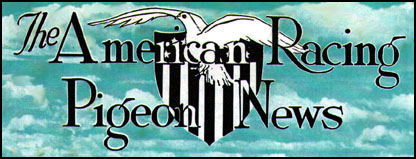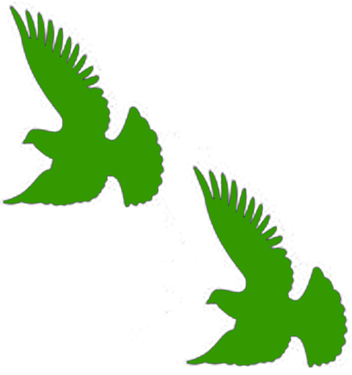
June 1984
Winging It
By Silverado
I'm going to break my rule and profile a loft again in this column. I rarely do it as its purpose is not to write about individuals but to share useful information and happenings. There are many levels of involvement in this sport and unfortunately the majority of the membership is involved only in their own loft and possibly to one extent or another in the club. Few men become real assets to the club (though many think so) and fewer yet move beyond the realm of the club into the combine and national involvement in the Sport. It's these few that, dependent upon their capabilities, make our sport grow and prosper.
In many instances the order members of the sport want to keep everything as it is, & the younger members want to make many changes. When you find an older member that can work with both and contributes equally, his value is beyond realization. This man has served as a consul, a spirit booster, and all around sounding board to this scribe over the years. There have been times when we disagreed but I've respected his opinion because it was asked for and given with sincerity and thought.
He's regarded as the grandfather of his very prestigious and top class club. Though not that old, I'm sure, considering the age of his fellow go-getters in the Lake County Club, I guess the title has merit. In all my visits and travels or associations with various clubs, no club appears to be more dynamic, display more ingenuity, work together better than the Lake County Club. I take nothing away from the rest of the membership or from their ladies when I say Horst Hackemer is a crucial part of this club's success. Always it's one thing to develop an idea and make it workable, it's quite another to get the support and help of other combine members, other clubs, etc. to put the original idea into the success area. Actually it's crucial and Horst is instrumental in this area.
Besides being a sounding board for me on occasion, he's served as a consul to several great flyers from around the country that I'm personally aware of and has been a supporter of both the "Help a Beginner" program and the Junior Race Fund. He also was instrumental in the success of the Great Lakes Classic Race which has grown into probably the most prestigious race in the Midwest and has followed up with the North Valley Combine Open which may soon have the participation and respect of the Great Lakes Classic. When you combine several of this caliber of men into one club, not only is the competition keen but they leave other clubs in their wake.
This is sufficient merit to justify the article but the good stuff is yet to come.
Horst has spared no expense to acquire two of the finest families of pigeons available in the world. Those that read my column regularly know I am not a Janssen fan but by the luck of fate, I've a pair that is tremendous by any standards and as a result have several of their children in the stock loft. As they say, the good ones are marvels. Horst also has the good ones. I didn't realize in all honesty how good till a friend of mine in La. was telling me about this great breeder Janssen down there. I asked if he could get a copy of the pedigree and behold the bird is off a pair of Horst's stock birds. I pursued it a little further and found out how terrific the whole family of the Vos stuff is that he has. More on this later.
He's traveled to Germain Imbrechts four times now and has a standing agreement for Y.B.'s from his newest champions. These Imbrechts have sold at the Great Lakes Classic Auction for $1200. Believe me, this isn't due to hype, it's due to the fact they are beating the tails off the old established families on 300 miles and up, particularly when the day gets a little tough. Admiral Weinel sent two into the Great Lakes Classic 3 years ago and they took 1st and 2nd by a sizable margin.
Last year Ken Wetzel won with a beauty of a silver hen that was a son of the young Naesson. It sold this past November for $1200 also. I bought a blue hen 3 years ago that bred the best two racers I've ever owned when I mated her to Stinger. It goes on and on. Jim McCabe recently told me he was a little disappointed in their early performance, then they went to 300 and were among the first home. He is now looking forward to putting them through their paces on the long races.
The Janssens
Horst called them large, but I've handled much bigger ones. I handled four generations of the Vos line and the size was coming down a hair. The Golden Vos was magnificent, his son was even better, it had a touch of frill on the neck. These two are both reds as were most the line and are responsible for many 1st combine winners for Horst and for several other flyers, top nationally known flyers as well.
Their flights were wide, the muscle was abundant & extremely supple and the eyes were an eyesign man's heaven. Wide, thick inner circles with a variety of ropes, bottle caps, etc.
I saw the mates for the eight imported cocks and there will be more dynamite birds raised this year in the Hackemer lofts. You have heard me speak of the outstanding loft of Janssens Jess Bighem owns in California. I believe I've said they were the best available that I've seen in this country. Horst Hackemer’s are equal!
Besides the Vos line he has the Merckx line of checkers. These were greatly involved in his latest All American Award. The depth of quality in this loft is phenomenal.
The Imbrechts
The long distance champion racing family of the world. Horst has sons and daughters, brothers and sisters to about every one of them. As I mentioned he's been to Germain's loft four times and each time makes a deal for a new key member to add to his colony.
If you have read some of the previous articles on the Imbrechts, you have a good idea as to the competition they win under and why they are considered the best in the world, also why most top lofts in the U.S. have some in just 2 or 3 short years since their publicity made them known in this country. When you see what Horst has there and take them in hand, that's when you believe and know why they are the best.
Methods
You are going to love this. For those of you that think there are secrets to becoming a nationally known pigeon flyer, read the conclusion to the article.
Widowhood training: It must be 40° or warmer, if at all possible, before training starts with the old birds. Ideally Horst likes 10 tosses at 30 miles on 10 consecutive days. Sometimes this works out. More often not, so it's modified. At this point they are mated so the cocks come home to the hen on the nest.
During the season, sometimes in the early races the birds may get a toss during the week and the hen is shown, the majority of the time there is no midweek training and the hens are not shown.
That's it gentlemen (and ladies)- tough way to race pigeons, isn't it?
Feeding
Horst feeds on the curve: light at the first of the week, medium in the middle and heavy at the end (how heavy depends on the distance). Light is, if it's an easy race they get straight barley, if a little harder they get wheat & milo. Medium is, 30% by volume maple peas, vetch peas and Canadian peas mixed with 30% white milo and 30% corn plus 10% whatever. Heavy means a lot of corn or high carbohydrates.
Medication
He medicates prior to breeding & prior to young birds the normal way we all do. However, he mixed Emtryl and Ampral at 1/2 teaspoon per gal. for 5 days and follows 2 to 3 days on vitamins. The vitamins he uses are Siegel's Pigeon Power, though he said he used Vitapol with equal benefit. He also uses Aviform because it gives terrific feather quality and seems to speed up the moult.
His breeders get Santos, a mineral supplement and sometimes he'll mix various mineral supplements to assure the breeders have all that's needed to produce top quality young birds.
Young Bird Training
They go 5 miles once or twice, a couple times 10 mi. or till coming good, then 22 mi. till coming good, then 30 miles and stays there. The birds are trained after they have exercised about the loft. If working right, he stays on line with them, if not he may take them most anywhere to sharpen them up. The longest toss they get is when he may come out to Belvidere for breakfast with Doug Hawes and they'll bring the birds that didn't go to the race that weekend for a 45 mile toss. He trains in small groups of 5 to 6 and sets up for a special money race by single or double tossing those birds. Special race young birds usually go to no races prior to that particular 300. His record doing this is enviable.
Breeding
He breeds straight and by family using muscle, conformation, performance and personality plus eyesign and in particular, eye color. He wants variation in the eyes of a pair not just in color but also the inner eye.
Because he sells Y.B.'s, he mates up the middle of February and breeds till October. He is extremely careful to keep his breeders fortified with supplements and his last rounds are as nice as his early rounds. Many visitors during the A.U. Convention last year remarked as to the excellent condition of the breeders.
Conclusion
Not only is Horst Hackemer involved in all levels of our sport and contributing to its existence with his work, his search and sharing of knowledge, but also with the extreme depth of quality of his pigeons.
If you don't have the quality birds, it's a constant struggle to make them excel. When you do have quality birds and use decent management, a little thought and some basic roadwork. you're going to win, and that is why Horst Hackemer has over 200 victories to his credit.
